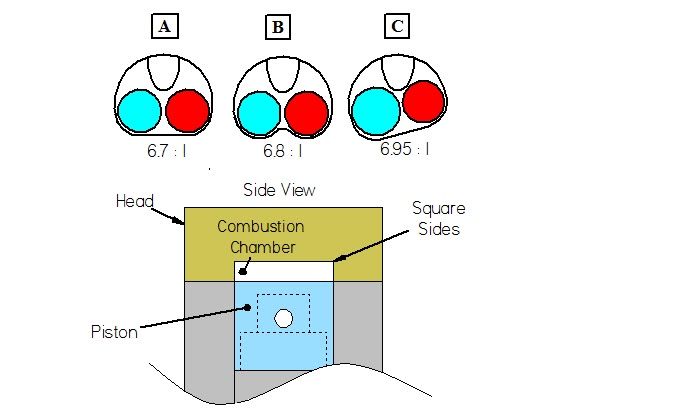With the cast iron sleeved aluminum pistons I think expansion is going to be a problem. A piston with an aluminum core will have to be loose in a steel bore when cold to avoid seizure when hot. The overall expansion of the piston will probably only be a little less than the aluminum, depending on how thick the sleeve is. You could also see distortion of the piston.
At our scale, runner lengths have very little impact on anything, but maybe Kel's main concern about how cylinders are fed. it's one reason Harley's have that rough idle. In the quest for power I'd be looking at airflow like Lakc mentioned. Combustion chamber shape won't be important at the displacement, compression ratios, and RPM you're talking about. If you really want to develop this design I'd consider building a single cylinder to do testing with. You'll find as breathing improves power will increase beyond the RPM you're running now. HP in little engines is found at high RPM. Even at 1.5cc per cylinder I'd expect HP to peak nearer to 10-12kRPM, or even closer to 20k if it could breath.
BTW, Kel, your TI4 has been giving me the itch to scale either BMW 4 or 6 cylinder and build one.
Greg
At our scale, runner lengths have very little impact on anything, but maybe Kel's main concern about how cylinders are fed. it's one reason Harley's have that rough idle. In the quest for power I'd be looking at airflow like Lakc mentioned. Combustion chamber shape won't be important at the displacement, compression ratios, and RPM you're talking about. If you really want to develop this design I'd consider building a single cylinder to do testing with. You'll find as breathing improves power will increase beyond the RPM you're running now. HP in little engines is found at high RPM. Even at 1.5cc per cylinder I'd expect HP to peak nearer to 10-12kRPM, or even closer to 20k if it could breath.
BTW, Kel, your TI4 has been giving me the itch to scale either BMW 4 or 6 cylinder and build one.
Greg














![MeshMagic 3D Free 3D Modeling Software [Download]](https://m.media-amazon.com/images/I/B1U+p8ewjGS._SL500_.png)




![DreamPlan Home Design and Landscaping Software Free for Windows [PC Download]](https://m.media-amazon.com/images/I/51kvZH2dVLL._SL500_.jpg)









































